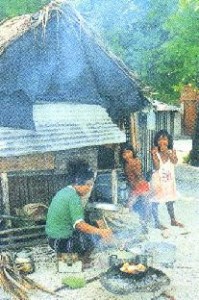1. Escaping the ‘Poison’
Jan. 31, 2013
Chapter 3: The Central, South Pacific and Australia
Part 1: The Nuclear Refugees of the Marshall Islands
Part 1: The Nuclear Refugees of the Marshall Islands
One year after the cities of Hiroshima and Nagasaki were destroyed by atomic bombs, the fourth nuclear explosion in history took place at Bikini, an atoll in the western chain of the Marshall Islands in the central Pacific Ocean. In the thirteen years that followed, the United States carried out a total of sixty-six nuclear tests on the two atolls of Bikini and Enewetak. It is just over thirty years since the last test was conducted, but on our visit to the neighboring islands, we found that the fallout from years of testing was still having a profound influence on the daily lives of the people there. Time, it appears, does not necessarily heal the wounds caused by nuclear testing.
1. Escaping the ‘Poison’
In May 1985, the three hundred inhabitants of the island of Rongelap, 120 miles east of Bikini, regretfully turned their backs on their island home and boarded a ship belonging to the international environmental organization Greenpeace. With them they carried all their worldly goods, from kitchen utensils to livestock. Their destination was the uninhabited island of Mejatto, 120 miles to the south.
Their new home was a small island on the northern edge of Kwajalein Atoll, and the islanders had no illusions that it would be any kind of promised land. Despite this the people had had no choice but to leave their homes on Rongelap, if they were to escape once and for all from what they had come to know as "the poison."
This poison is more commonly called radioactive contamination. The history of the poison which eventually drove the Rongelap islanders from their home goes back thirty years to the mid-1950s. At dawn on March 1, 1954, America's first hydrogen bomb, "Bravo," was exploded at Bikini Atoll the infamous test which caused the twenty-three crew members of the Japanese fishing boat Daigo Fukuryu Maru to be exposed to high doses of radiation. Radioactive fragments of coral and ashes, carried by the westerly wind, fell like snow east of Bikini, seriously contaminating the island of Rongelap.
The islanders were overcome by all the symptoms of acute radiation sickness: severe bouts of vomiting, inflammation of the skin, and hair loss. Taken off this island by the U.S. Navy, the islanders were forced to spend three years drifting from place to place living off food supplies from the United States. In 1957, they were informed that it was safe to go home, so they returned to Rongelap.
Nelson Anjain, who served as our interpreter during the visit, spoke to us about the islanders' return home: "Nothing at all seemed to have changed in the three years we had been away. But when we tried to eat the coconuts and the roots of plants growing on the island, we all came down with diarrhea. We soon realized that this wasn't the same place that we had left."
About ten years after their return, illnesses previously unknown on Rongelap, such as cancer of the thyroid and leukemia, began to afflict the islanders. Medical teams came from the United States once every two years and took those in need of treatment back to hospitals in Hawaii and on the mainland. Every year, with chilling regularity, someone would die of one of these illnesses. Many of those who fell ill were children. People began to blame the poison, and wanted to flee the island.
"I felt that I was really too old to move," a former Rongelap resident told us. "But when I thought of what the poison might do to my children and grandchildren, I knew we had no choice but to leave."
We traveled by motorboat for ten hours to the island of Mejatto to speak with the Rongelap islanders. Ajji Kun, a father of three, told us wistfully that, in comparison to their old home, the island was not blessed with coconuts or breadfruit in great quantities, nor was the fishing very good.
The islanders were in a state of chronic undernourishment, having to rely mainly on erratic food aid from the United States. They had been living this way for four years, barely managing to keep their heads above water, when they began to realize that their lives were once again in danger. Even though they had escaped from the fallout of Rongelap, they could not escape from the radioactive substances that had been absorbed into their bodies.








